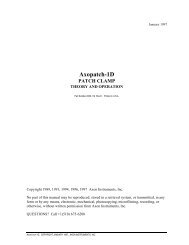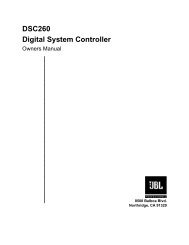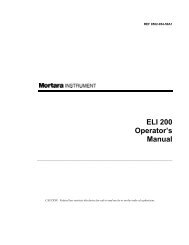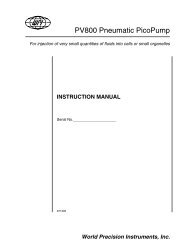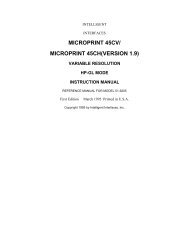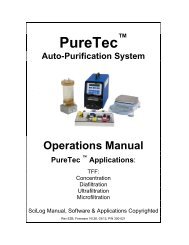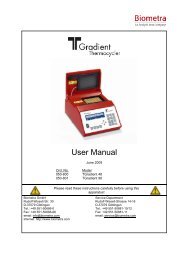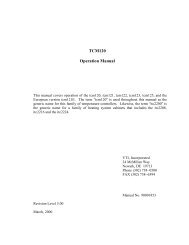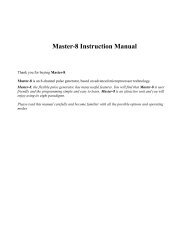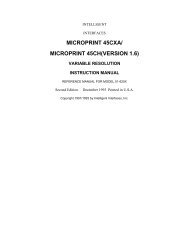Chromatotron
Chromatotron
Chromatotron
You also want an ePaper? Increase the reach of your titles
YUMPU automatically turns print PDFs into web optimized ePapers that Google loves.
If a pump is used for solvent supply:<br />
* Pump solvent to the <strong>Chromatotron</strong><br />
until the sorbent is completely<br />
wetted and allow a further 5 min<br />
or more for equilibration.<br />
* Take up the sample solution through<br />
the filter and pump input tube.<br />
The sample must be completely in<br />
solution. Filter or centrifuge<br />
as required.<br />
* Flush the last traces of the sample<br />
into the filter and tube using<br />
several squirts of solvent.<br />
* Return the filter and input tube<br />
to the solvent reservoir.<br />
The volume of solvent used to add the sample is not as critical as for regular<br />
prep TLC although the concentration should not exceed about 10%. The high<br />
viscosity of more concentrated solutions will distort bands on the rotor. Sample<br />
solution volumes of 1-2 ml (per mm of layer thickness) are usual but volumes<br />
as large as 4-8 ml (i.e. up to about 30 ml for a 4 mm layer) will give reasonably<br />
narrow bands. If a band is broad it will sharpen as the development proceeds.<br />
There is no reason to have initial bands of less than about 4 mm width since<br />
resolution will not be improved.<br />
It is possible to introduce the sample after wetting only a small part of the rotor<br />
with solvent. Under these non equilibrium conditions relative Rf values and the<br />
separations obtained may be abnormal. Evaporation in the solvent collection<br />
channel will cause slight but usually acceptable tailing of fractions.<br />
Introducing Less Soluble Samples (l and 2 mm layers only). If samples will<br />
not dissolve in a reasonable volume of solvent, wet the rotor completely with a<br />
more polar solvent, introduce the sample in this solvent, allow a few minutes<br />
for solvent to drain from the rotor and then dry out the sorbent with an<br />
increased nitrogen flow (1-1.5 L/min). Elution can then be performed with the<br />
desired solvent. Use sufficient of the polar solvent to form a broad band; a<br />
narrow band may crystallize on drying out. The solvent evaporation is very<br />
slow since the rotor becomes cold; 45-75 min will be needed. Do not take off<br />
the Teflon lid to speed up evaporation; water will condense on the cold<br />
sorbent.<br />
13



